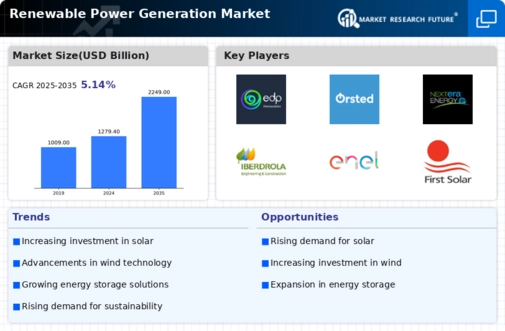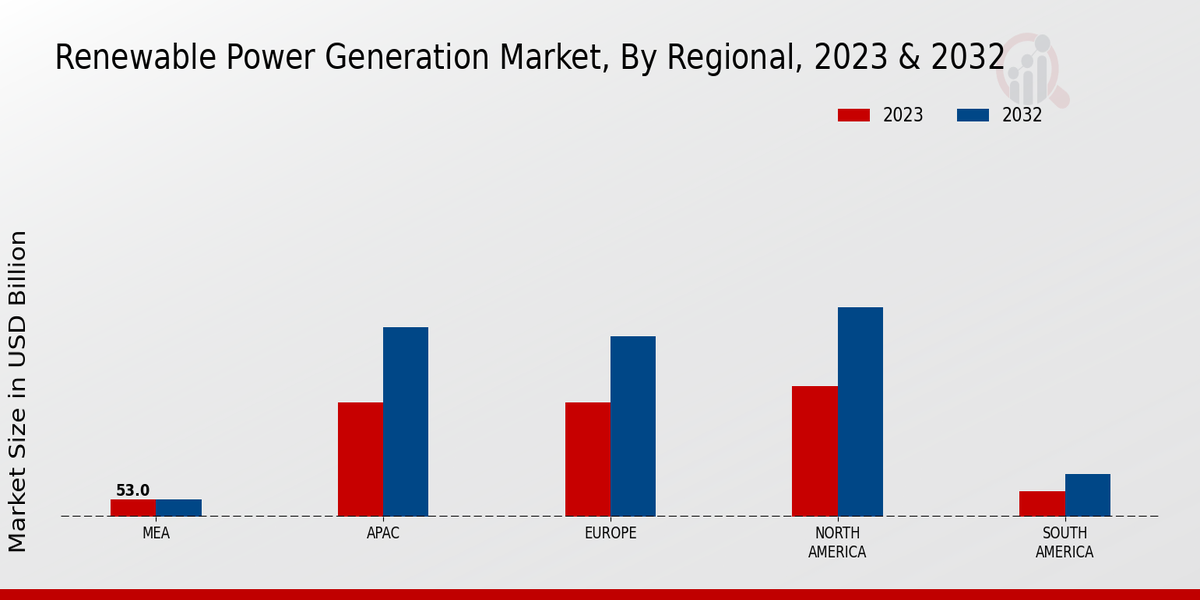Rising Energy Prices
Rising energy prices are influencing the Global Renewable Power Generation Market Industry by making renewable energy sources more attractive. As fossil fuel prices fluctuate and often increase, the cost-competitiveness of renewables becomes more pronounced. This trend encourages both consumers and businesses to explore renewable options, as they seek to mitigate energy costs. For instance, the decreasing costs of solar and wind energy have made them viable alternatives to traditional energy sources. Consequently, the market is expected to benefit from this shift, as more stakeholders recognize the long-term economic advantages of investing in renewable energy solutions.
Market Growth Projections
The Global Renewable Power Generation Market Industry is projected to experience substantial growth, with estimates indicating a market size of 1279.4 USD Billion in 2024 and a remarkable increase to 2249.0 USD Billion by 2035. This growth trajectory suggests a compound annual growth rate (CAGR) of 5.26% from 2025 to 2035, reflecting the increasing global emphasis on sustainable energy solutions. The expansion of renewable energy sources, coupled with supportive government policies and technological advancements, is likely to drive this market growth. As stakeholders recognize the potential of renewables, the industry is poised for a transformative shift towards a more sustainable energy future.
Technological Advancements
Technological advancements play a pivotal role in the Global Renewable Power Generation Market Industry, enhancing the efficiency and cost-effectiveness of renewable energy systems. Innovations in solar panel technology, wind turbine design, and energy storage solutions are driving down costs and improving performance. For instance, the development of bifacial solar panels has increased energy capture, while advancements in battery technology are enabling better energy storage capabilities. These improvements not only make renewable energy more accessible but also contribute to the industry's growth trajectory. As technology continues to evolve, it is expected that the market will maintain a compound annual growth rate (CAGR) of 5.26% from 2025 to 2035.
Government Policies and Incentives
Government policies and incentives are crucial drivers in the Global Renewable Power Generation Market Industry, as they create a favorable environment for investment and development. Many countries have established renewable energy targets and financial incentives, such as tax credits and subsidies, to encourage the transition to renewable sources. For example, the United States has implemented the Investment Tax Credit (ITC) for solar energy, which has significantly boosted installations. Similarly, the European Union has set ambitious targets for renewable energy consumption, further propelling market growth. These supportive measures are likely to enhance investor confidence and stimulate innovation within the sector.
Increasing Demand for Clean Energy
The Global Renewable Power Generation Market Industry is witnessing a surge in demand for clean energy solutions as nations strive to meet climate goals. This demand is driven by a growing awareness of environmental issues and the need to reduce greenhouse gas emissions. In 2024, the market is projected to reach 1279.4 USD Billion, reflecting a robust shift towards renewable sources such as solar, wind, and hydroelectric power. Governments worldwide are implementing policies and incentives to promote renewable energy adoption, further fueling this trend. As a result, the industry is likely to experience sustained growth, with projections indicating a market size of 2249.0 USD Billion by 2035.
Growing Investment in Infrastructure
Growing investment in infrastructure is a significant driver of the Global Renewable Power Generation Market Industry, as it facilitates the deployment of renewable energy technologies. Governments and private entities are increasingly allocating funds to develop the necessary infrastructure for renewable energy generation, such as wind farms, solar parks, and grid enhancements. This investment not only supports the expansion of renewable capacity but also improves energy access in underserved regions. As infrastructure projects progress, they are likely to create a more resilient energy system, further promoting the adoption of renewable sources and contributing to the overall growth of the market.























